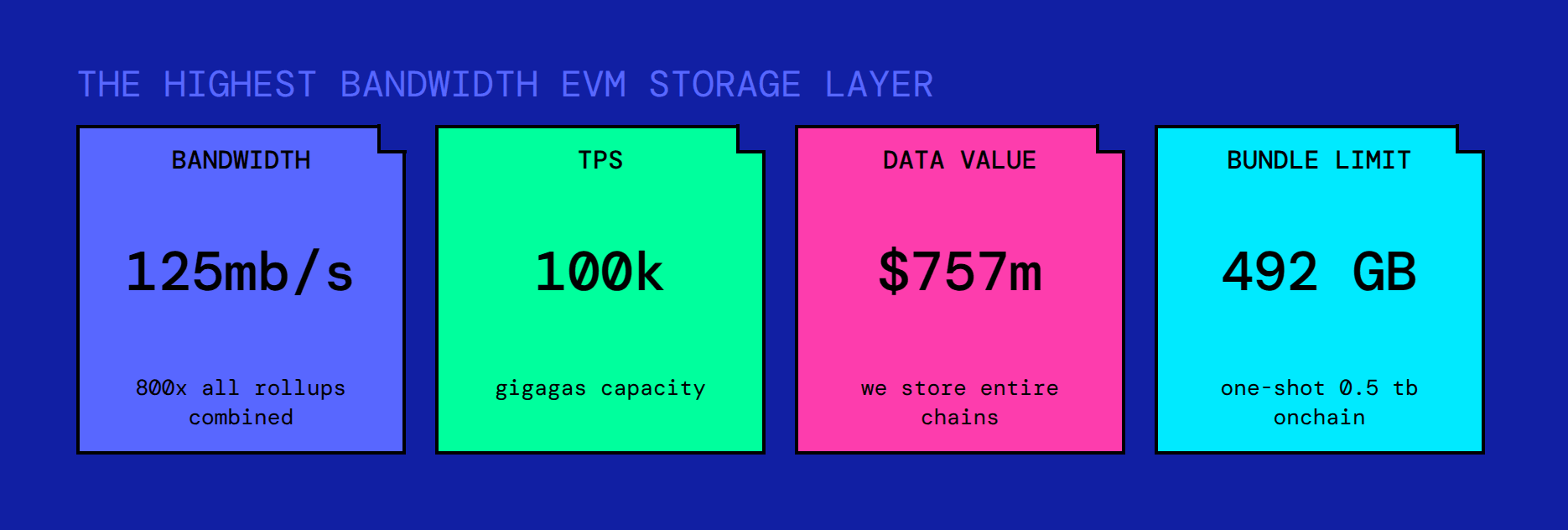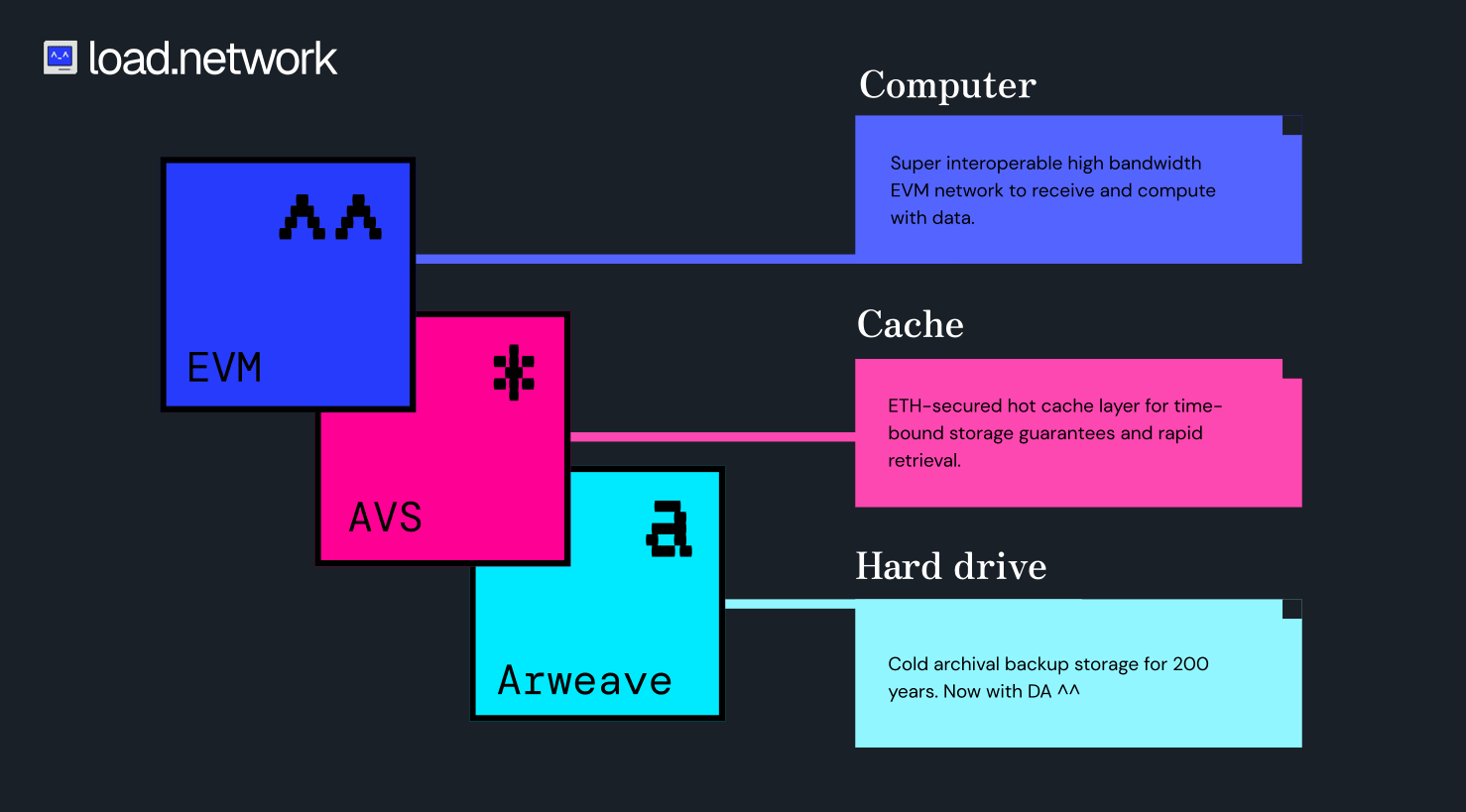WeaveVM started life in late 2023 with the mission of building the EVM compatibility layer for Arweave storage.
As the single largest data protocol on Arweave by monthly transaction volume since launch (~5,000,000 /mo) we’ve been integrated as the storage layer for chains like Avalanche, Metis, RSS3. We’ve been integrated as DA for Dymension, secured indexed blobs for Blobscan, and built blob permanence for EigenDA.
We’ve seen this mission become a reality and our original name fit that scope – but by pushing the limits of what’s possible on the EVM, the network has evolved.
Load Network is the onchain data center
Load Network combines the interoperability, UX and developer tooling of the Ethereum ecosystem with something it has never before had access to:
Unbounded storage and high-bandwidth compute, at an affordable rate, ready to drop into your chain, DA layer or dApp as easily as you’d integrate a cloud service.
L2s were an incremental improvement to the EVM ecosystem. Load goes from 0 → 1.
Breaking the EVM storage barrier
Data centers feel limitless, and that’s what we’re working towards.
Load Network expands the limits of EVM data with a new transaction format which enables bundles of up to 492GB. This is a massive step up from standard EVM chains where transactions are typically limited to kilobytes.
For perspective on both max theoretical bandwidth and Load Network’s demand today – Load Network is currently processing ~40% more transactions than Celestia and has 700 times more bandwidth. Its single bundle limit can contain an entire year of Ethereum’s ledger history, hundreds of hours of HD video, a complete Llama AI model, or data equivalent to several days of Celestia’s throughput – in one transaction. This makes it possible for EVM applications that need to natively store large amounts of data onchain, from AI models to media, research data, DePIN feeds, and RWA data.
By solving the storage constraints that have limited EVM applications, Load Network opens up entirely new categories of onchain applications – data-intensive dApps, decentralized archive nodes, high-throughput DA, on the most widely adopted compute standard.
What onchain EVM data unlocks
The EVM is home to some of the most widely adopted censorship resistant applications the world has ever seen, but most still use third party web2 services to store data. On an average EVM chain, it’s simply too expensive to store meaningful amounts of data. This creates a critical centralization vector for dApps that could otherwise live forever but are at the mercy of recurring SaaS bills – and even vulnerable to Bybit hack-style attack vectors where offchain data becomes difficult to verify.
Decentralization aside, onchain data is becoming more vital for automation. Agents make decisions based on the data they can see, so the more that is accessible rather than hidden behind centralized endpoints or siloed content hashes, the more powerful they can be.
In Load Network, data from the storage layer is natively accessible inside smart contracts. Unlike typical EVM networks like Ethereum, Load can retrieve and compute with any data from the network, from Arweave, or any other integrated source.
Load Network combines storage, DA and compute into a single layer built from modular components. One of these key components is Arweave – permanent data is a vital promise Load Network makes, but that’s not where it starts and ends.
The Load AVS layer
One of the core challenges with archival storage is that it loses ease-of-verifiability once settled. Load Network has already seen adoption for data availability inside EigenDA and Dymension stacks, and with its ability to handle over 800x the combined egress of all rollups tracked by rollup.wtf, combining bandwidth with permanence and verifiability is an important part of the mission.
For that, Load Network will expand to include a new EigenLayer-powered hot cache layer that sits between the EVM front door and Arweave cold storage to provide Ethereum-secured data guarantees, priced by GB/mo.
As part of the onchain data center’s mission, we envision decentralizing not just the way data is stored but the way it is sent to and from the network.
Right now, the most popular way to upload data is with a bundling service – a machine that takes one or more files, packs them together, and covers the cost to store them on the network. Load’s AVS layer will provide both hot cache storage and the basis for a decentralized marketplace of bundling service operations, incentivized to upload, cache and serve Load data as part of a robust decentralized network.
Interoperable with what you already use…
History has shown that networks live and die by interoperability. It’s hard to find adoption for novel standards and libraries that are radically different from what everyone else is using.
Standards became popular for a reason, but it doesn’t mean they are built on the best foundations. This is a major reason why Load Network is EVM-first, but also why we are focused on building 1:1 compatible developer tooling for existing web2 and web3 storage layers.
Load Network is a drop-in replacement for IPFS, Filecoin, Swarm, and Amazon S3, with the goal of making it as easy to use Load as switching a single line of code.
Beyond storage and DA, we are committed to build deep EVM interoperability with ao, Arweave’s flagship compute network that can run applications impossible elsewhere.
…and with the future of complex compute
Load Network will support two types of program: EVM smart contracts, and ao processes.
Rather than rebuilding EVM functionality within ao, Load uses a shared sequencing architecture — a bidirectional data pipeline that allows both ecosystems to use each other’s strengths without compromise.
For ao, this unlocks trustless asset bridging with EVM-standard tokens, cross-chain data, access to the entire EVM dApp ecosystem including Uniswap and Maker, and permissionless integration with EVM wallets and tooling.
For EVM networks, this provides access to ao’s decentralized agents that bypass Solidity limitations through WASM processes, offloading complex compute tasks trustlessly, and first class support for Arweave wallets. Since ao processes can run without external triggers, ao can be seen as Load’s automation layer.
Infinitely ExExpandable
Built on Reth, Load Network’s architecture uses Execution Extensions (ExExes) as plugins to support new networks and data pipelines. This modular design makes Load able to quickly add support for new standards, data layers, and ETL processes.
With ExExes, Load Network built the first ever EVM data pipelines with Arweave, Google Big Query, and ao’s WeaveDrive spec (AOP-5). We maintain a catalog of Reth ExExes at exex.rs, and everything we build can be adopted by any EVM network running Reth as a commitment to open source.
The future of Load Network
With a vision to become the onchain data center, Load Network is focused on scale and interoperability – scaling the core capabilities of the network to increase bandwidth and decrease latency, and widely integrating with the stacks developers already use to make onchain storage the smart default for building decentralized applications, not AWS + token.
Check out the Load Network ecosystem to see who’s already using Load and get involved yourself. Reach out on X if you want to build the future of onchain data.



